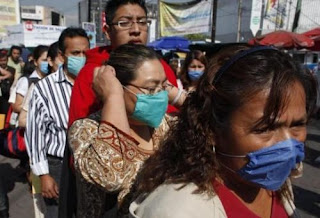The 2009 flu pandemic is a global outbreak of a new strain of influenza A virus subtype H1N1, termed Pandemic H1N1/09 virus by the World Health Organization (WHO), that was first identified in April 2009. The disease has also been termed novel influenza A (H1N1) and 2009 H1N1 flu by the U.S. Centers for Disease Control and Prevention (CDC), and is commonly known as swine flu. The main strain of virus has been termed A/California/07/2009 (H1N1) by scientists.
The outbreak was first observed in Mexico, with evidence that there had been an ongoing epidemic for months before it was officially recognized as such. The Mexican government soon closed most of Mexico City's public and private offices and facilities to contain the spread of the virus. As the virus quickly spread globally, clinics were overwhelmed by testing and treating patients, and the WHO and the CDC eventually stopped counting all cases and focused instead on tracking major outbreaks. On June 11, 2009, the WHO declared the outbreak to be a pandemic.
Only mild symptoms are experienced by the overwhelming majority of victims, but there are exceptions. Some persons are in higher risk groups, such as those with asthma, diabetes,obesity, heart disease, children with neurodevelopmental conditions, or persons who are pregnant or have a weakened immune system. There are small subsets of patients, even among young persons previously healthy, who rapidly develop severe pneumonia, typically 3 to 5 days after initial onset of symptoms. Deterioration can be very rapid, with many patients progressing to respiratory failure within 24 hours, requiring intensive care and ventilation support.
Like other influenza viruses, swine flu is typically contracted by inhaling air that has been contaminated by an infected person coughing or sneezing, or by touching one's nose or mouth with hands that have previously touched contaminated surfaces and have not been disinfected. Symptoms, which last up to a week, are similar to those of seasonal flu, and can include fever, sneezing, sore throat, cough, headache, and muscle or joint pains. To avoid spreading the infection, the CDC recommended that those with symptoms stay home from school, work, and crowded settings; wearing facial masks was not recommended except in health care settings.
Source: http://en.wikipedia.org/wiki/2009_flu_pandemic
Friday, November 20, 2009
Subscribe to:
Post Comments (Atom)

No comments:
Post a Comment